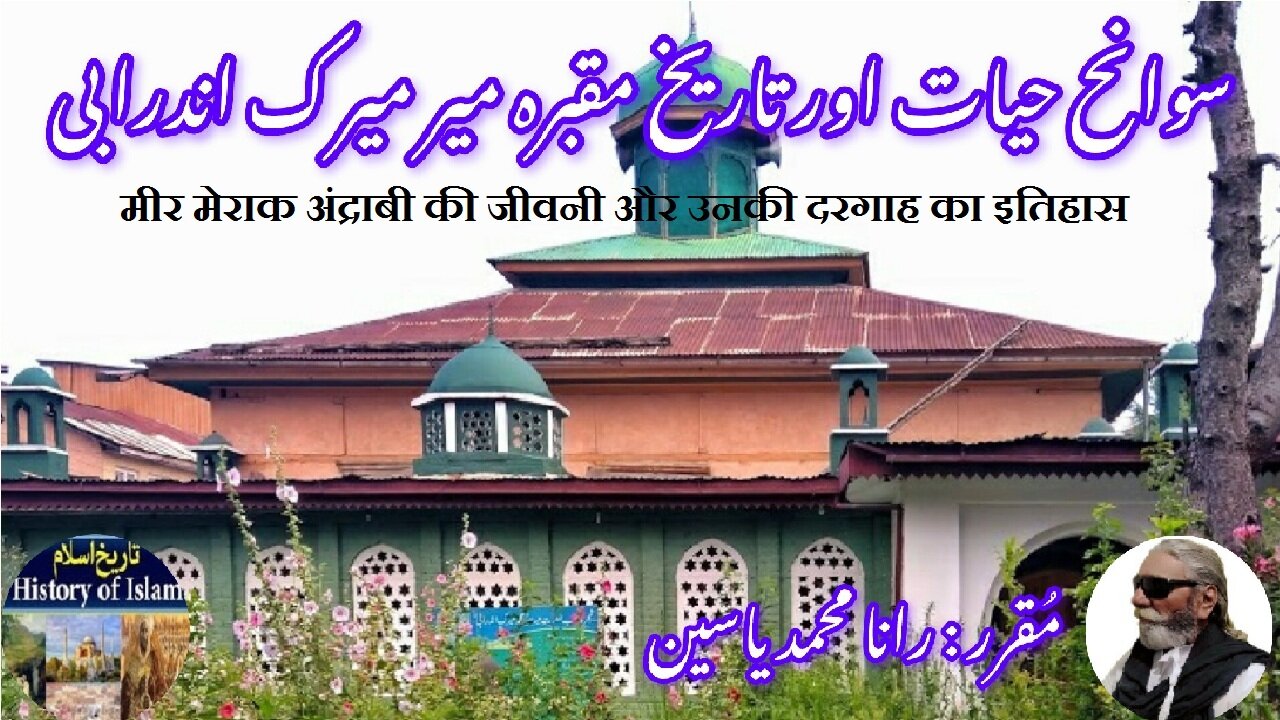Premium Only Content

Mir Merak Andrabi and history of his shrine میر میرک اندرابی کی سوانح حیات اور ان کے مزار کی تاریخ
@islamichistory813 #sufisaint #cultural #heritage #biography #islamic #mysticism #islamic #philosophy #shrine #historical #figures
Biography of Mir Mirak Andrabi and the history of his shrine
Dekhti Aankhooon aur sountay kaanoon ko Asslamoalaikum, sisters, brothers friends and elders, in informative series videos of Islamic ascolars, sufisaints, cultural heritages, islamic philosophys, islamic mysticisms and historical figures. today we are describing biography of Mir Mirak Andrabi and the history of his shrine.
Mir Mirak Andrabi (921–990 AH / c. 1515–1582 AD) was a revered Sufi scholar and spiritual guide in South Asia, particularly in the Kashmir Valley. He was born in 921 AH (around 1515 AD) in the region of Kashmir, into a prominent family of spiritual scholars who traced their ancestry to Andarab, a valley in present-day Afghanistan. This lineage gave rise to the respected Andrabi clan in Kashmir, a family known for its deep-rooted association with Islamic learning, Sufism, and religious service. Mir Mirak Andrabi was the son of the distinguished Sufi master Shams-ud-din Andrabi (860–932 AH / c. 1455–1525 AD), who himself was a major spiritual influence in the valley and contributed to the spread of Islam and Sufi teachings during his time.
Mir Mirak inherited the spiritual legacy and intellectual depth of his father and forefathers. From an early age, he was immersed in religious studies and spiritual training. His education included mastery of the Qur'an, Hadith, Islamic jurisprudence (Fiqh), theology (Aqidah), and Persian and Arabic literature. However, it was Sufism—the path of inward purification and closeness to God—that most deeply shaped his life and mission. Under the spiritual mentorship of his family elders and local scholars, Mir Mirak developed into a respected Sufi scholar who not only embodied deep inner spirituality but also became a source of guidance for others.
The Andrabi family’s migration from Andarab to Kashmir played a significant role in shaping the spiritual landscape of the region. As his great-grandfather Ahmad Andrabi had made Kashmir his home generations earlier, Mir Mirak Andrabi represented the third or fourth generation of this distinguished lineage within Kashmir. By the time of Mir Mirak's birth, the family was firmly established and respected for their piety, scholarship, and leadership in Islamic matters. Mir Mirak carried this tradition forward with exceptional dedication.
Mir Mirak Andrabi is best known for his contributions to the development of Sufi culture in Kashmir. He played a central role in spreading the teachings of love, compassion, humility, and divine remembrance that lie at the heart of Tasawwuf (Sufism). He engaged with the people not only as a religious scholar but also as a spiritual doctor who healed hearts and uplifted souls. His manner was marked by simplicity, sincerity, and spiritual insight, which made him beloved among the common people and respected among scholars.
He also established a **Khanqah** (Sufi lodge) known as *Khanqah-e-Andrabia*, located in **Malaratta (Malla Iraqi Hatta)**, an important part of the city of Srinagar in Kashmir. The Khanqah became a vital center for spiritual learning, communal worship, and social reform. It was here that seekers of truth would gather to attend his discourses, participate in dhikr (remembrance of God), and receive spiritual guidance. The Khanqah-e-Andrabia was more than just a religious building; it served as a center of moral and ethical training and played a pivotal role in community development. Over the years, this institution became a spiritual beacon in the region, influencing generations of Kashmiris.
Mir Mirak Andrabi lived a life marked by devotion to God, service to humanity, and the pursuit of knowledge. His teachings, preserved through oral tradition and written accounts, emphasize the unity of God (Tawhid), the importance of inner purification (Tazkiyah), and the necessity of love and service in the path of Islam. He avoided political involvement and instead focused on spiritual reform, ethical living, and community building.
He passed away in 990 AH (approximately 1582 AD) in Kashmir, where he had spent his life teaching and guiding others. His death marked the end of a luminous chapter in the history of Sufism in the region, but his legacy endured through his descendants, disciples, and the institution he left behind.
Mir Mirak Andrabi was buried near the **Khanqah-e-Andrabia** at **Malaratta**, where his **shrine** remains a site of pilgrimage and spiritual reflection. The shrine, constructed by his followers and maintained by the Andrabi family and the local community, continues to attract devotees who come to seek blessings, pray, and remember his teachings. The structure of the shrine reflects the traditional Kashmiri architecture and embodies the serene atmosphere associated with Sufi spaces. It stands as a testament to the enduring influence of Mir Mirak Andrabi and the spiritual path he represented.
Today, Mir Mirak Andrabi is remembered as one of the key Sufi figures in Kashmiri history. His role in promoting Islamic values, nurturing spiritual seekers, and enriching the cultural and religious fabric of the valley remains widely acknowledged. His shrine continues to be a spiritual center, where the legacy of love, knowledge, and divine remembrance is kept alive through the ongoing traditions of the Khanqah-e-Andrabia.
With this, we seek your permission until tomorrow, tomorrow we will describe the biography of Shaykh Hamid-i Vali and the history of his Shrine.
Allah Hafiz
==============================
-
 9:12
9:12
ISLAMIC HISTORY
23 hours agoWhat is the Main Message of Surah Yunus سورہ یونس کا اصل پیغام کیا ہے؟
1 -

BEK TV
17 hours agoTrent Loos in the Morning - 10/02/2025
8.35K2 -
 1:26
1:26
WildCreatures
14 days ago $0.90 earnedCow fearlessly grazes in crocodile-infested wetland
3.49K1 -
 29:54
29:54
DeVory Darkins
1 day ago $14.43 earnedHegseth drops explosive speech as Democrats painfully meltdown over Trump truth social post
53.4K69 -
 19:39
19:39
James Klüg
1 day agoAnti-Trump Protesters Threaten To Pepper Spray Me For Trying To Have Conversations
15.7K18 -
 34:54
34:54
MattMorseTV
13 hours ago $26.01 earned🔴Trump just FIRED 154,000 FEDERAL WORKERS. 🔴
72.4K93 -
 2:03:32
2:03:32
Side Scrollers Podcast
21 hours agoMASSIVE Netflix Boycott + The TRUTH About Jimmy Kimmel’s Return + BIG Side Scrollers NEWS
35.6K15 -
 15:05
15:05
GritsGG
1 day agoFlawless Duos Victory w/ Most Winning Duo in Warzone History!
32.5K2 -
 1:53:52
1:53:52
FreshandFit
17 hours agoShe Was In 3 Domestic Violence Cases? Happy Birthday Fresh!!!
161K66 -
 2:03:22
2:03:22
Inverted World Live
9 hours agoThe Aliens Are Underwater | Ep. 117
78.8K29